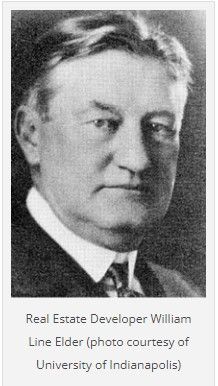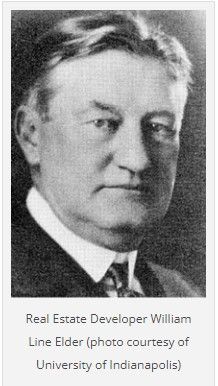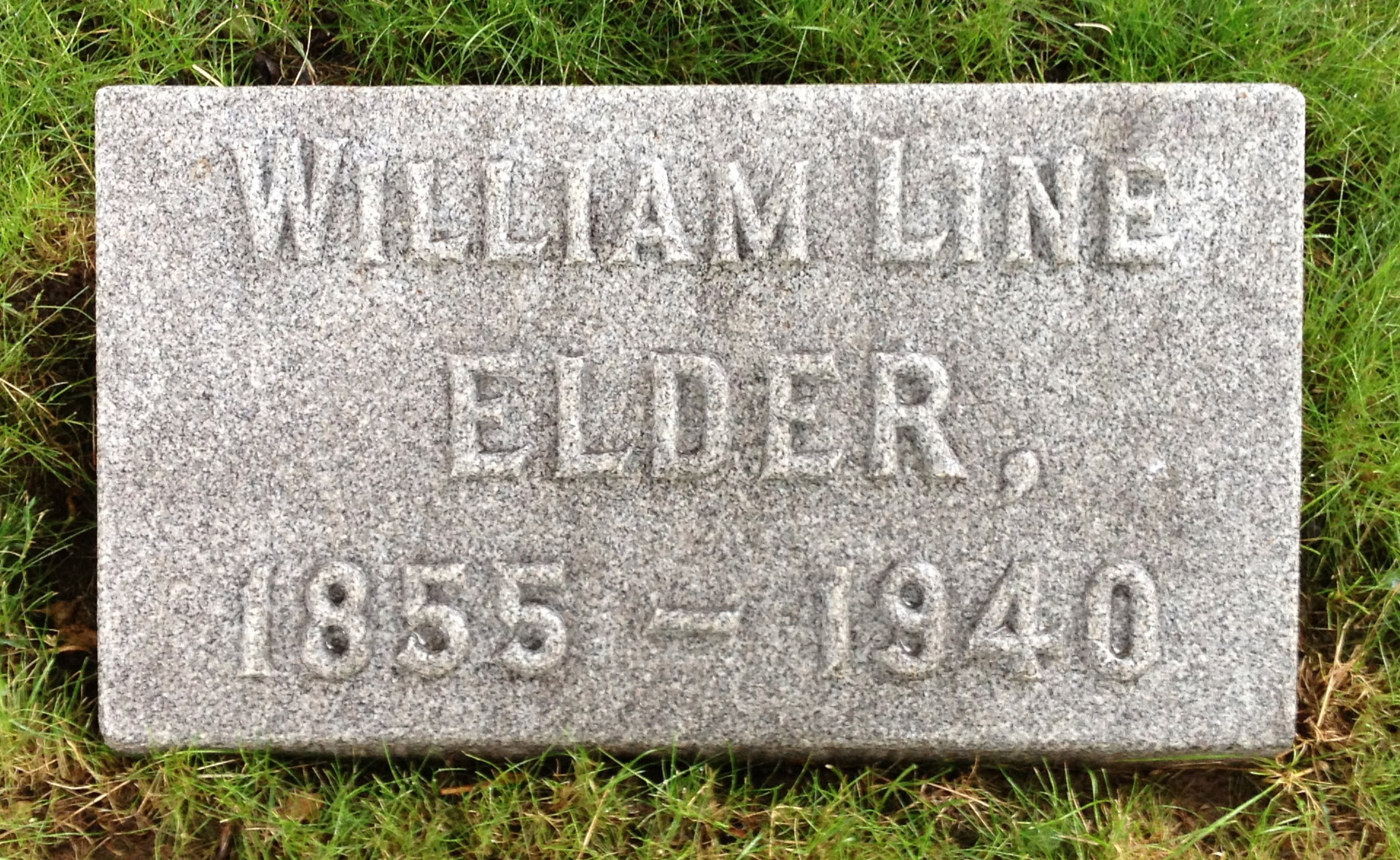William Line Elder, 84 years old, Indianapolis business and civic leader for 50 years and a close friend and confidant of Thomas R. Marshall, former Vice President of the United States and former Governor of Indiana, died yesterday in his apartment in the Spink-Arms Hotel. Mr. Elder had retired from active business seven years ago when he was injured by an automobile. He had been in ill health since that time.
Prior to his retirement, Mr. Elder had been engaged since 1900 in the real estate business. He and his son, Bowman Elder, operated the firm. A lifelong Democrat, Mr. Elder was appointed Indiana collector of internal revenue by President Woodrow Wilson in 1919, and in 1930 was appointed Indianapolis city controller in the first administration of Mayor Reginald H. Sullivan. Closely associated with Mr. Marshall throughout the latter's life, Mr. Elder became administrator of the Marshall estate at the firmer Vice President's death.
Born in Indianapolis July 31, 1855, Mr. Elder was the son of John R. Elder and Amelia Line Elder. He was a graduate of the old Indianapolis High School. On October 21, 1885, Mr. Elder was married to Laura Bowman of Springfield, Ohio.
Mr. Elder's business career began in 1877 when he became cashier at the Bank of Commerce of Indianapolis. In 1883 he was made paymaster of the Indiana, Decatur & Springfield Railroad, and from 1893 to 1897 was vice president of the Indianapolis Street Railway Company.
At the time Mr. Elder was appointed Indiana internal revenue collector, the office stood in 82nd place in efficiency, compared with other internal revenue offices in the nation. Mr. Elder took pride in the fact that when he turned the office over to his successor, it stood second in efficiency.
Always active in real estate, Mr. Elder platted a number of subdivisions in Indianaoplis including Washington Place, Fairfields, Edgewood, and University Heights--the last plate taking its name from the fact that Mr. Elder erected a college building there, now the property of the United Brethren Church. The college then established was regarded as the nucleus of the present Indiana Central College.
Mr. Elder was president of the Indianapolis Real Estate Board in 1919. He was vice president of the board of managers of Crown Hill Cemetery. He was a governor of the Indiana Real Estate Association and had been a member of the National Real Estate Association's committee on taxation. On November 4, 1925, he was appointed a member of the board of trustees of the Indiana World War Memorial. He resigned in 1933 owing to ill health. Mr. Elder was a member of the First Presbyterian Church, the Indiana Society, Sons of the Revolution, Indiana Democratic Club, Indianapolis Country Club, and the Indianapolis Dramatic Club.
Survivors are the widow, the son, and two grandchildren. Private funeral services will be held in the Kregelo and Bailey funeral home on North Meridian Street at 2 o'clock tomorrow afternoon. Private burial will be in Crown Hill Cemetery.
------------------
William Line Elder was a land developer and acquired land that had originally been purchased by Richard Carnine and Henry Comingore. Elder was also the developer of a number of other subdivisions, including Armstrong Park, Clifton Place, Northwestern Park, Elder's Washington Place Heights, and Eastern Heights. It was Elder's intention to develop all of the acreage as a housing addition called Marion Heights. Around the same time Elder was planning his new Marion Heights community, there was discussion among the leaders of the Church of the United Brethren in Christ about building a college in central Indiana. Many students had been leaving Indiana to attend Brethren-related schools in other states, including Otterbein University in Westerville, Ohio, and Westfield College in Westfield, Illinois.
One of the proponents of establishing a Brethren-related college in central Indiana was Rev. Dr. William M. Karstedt (1861-1937), who was minister of the First United Brethren Church. The church was located on the northwest corner of East 21st Street and Central Avenue when Karstedt first became its pastor. The building still stands today, now owned by Promise Place Ministries. In 1907, the congregation of First United Brethren built a more substantial building on the southeast corner of St. Clair and Park Avenue in the Chatham-Arch Historic District. That building is now the home of the Phoenix Theatre.
William Elder proposed an arrangement that proved to be mutually beneficial to both the Brethren Church and Elder himself. Elder offered to donate eight acres of his land for the founding of a school, as well as to pay for the construction of the campus's first building, provided the church would help him to find buyers for his remaining 446 residential building lots. The church leaders agreed to the plan, and William Karstedt went to work selling lots in William Elder's new housing addition, which by then had been renamed University Heights. Karstedt himself built a house there and moved his family to the neighborhood. Later, he built a general store at Shelby and Hanna, immediately west of Shelby Street and alongside the Jefferson Madison & Indianapolis Railroad (JM&IRR) tracks.
By the spring of 1904, a significant number of the lots had been sold, and William Elder began construction on the college's first building, as promised. It was completed in just six months. Indiana Central University opened its doors to it first students on September 27, 1905. The university's first commencement was held in the spring of 1908, during which proceedings two students received diplomas.
While ICU's early years were sometimes marked by struggles for sheer existence, by mid-century the school was clearly headed for solid ground. Attention began to shift from planning for survival to planning for expansion and excellence. Beginning with the construction of Academic Hall, which was the first new building in three decades, several new buildings were erected on campus, and the improved facilities made it possible for many new programs and activities to be initiated. Musical and theatrical productions were mounted. A lecture series was started. Radio station WICR 88.7 began broadcasting. The college sponsored a state-wide science fair for junior and senior high school students. Summer school classes were offered. International programs were instituted, including a remote campus in Greece. The University of Indianapolis remains the most prominent cultural institution on the southeast side, a role that continues to expand as new programs are created and new facilities are built.
historicindianapolis.com Sharon Butch Freeland, freelance researcher, writer, proofreader, and editor
William Line Elder, 84 years old, Indianapolis business and civic leader for 50 years and a close friend and confidant of Thomas R. Marshall, former Vice President of the United States and former Governor of Indiana, died yesterday in his apartment in the Spink-Arms Hotel. Mr. Elder had retired from active business seven years ago when he was injured by an automobile. He had been in ill health since that time.
Prior to his retirement, Mr. Elder had been engaged since 1900 in the real estate business. He and his son, Bowman Elder, operated the firm. A lifelong Democrat, Mr. Elder was appointed Indiana collector of internal revenue by President Woodrow Wilson in 1919, and in 1930 was appointed Indianapolis city controller in the first administration of Mayor Reginald H. Sullivan. Closely associated with Mr. Marshall throughout the latter's life, Mr. Elder became administrator of the Marshall estate at the firmer Vice President's death.
Born in Indianapolis July 31, 1855, Mr. Elder was the son of John R. Elder and Amelia Line Elder. He was a graduate of the old Indianapolis High School. On October 21, 1885, Mr. Elder was married to Laura Bowman of Springfield, Ohio.
Mr. Elder's business career began in 1877 when he became cashier at the Bank of Commerce of Indianapolis. In 1883 he was made paymaster of the Indiana, Decatur & Springfield Railroad, and from 1893 to 1897 was vice president of the Indianapolis Street Railway Company.
At the time Mr. Elder was appointed Indiana internal revenue collector, the office stood in 82nd place in efficiency, compared with other internal revenue offices in the nation. Mr. Elder took pride in the fact that when he turned the office over to his successor, it stood second in efficiency.
Always active in real estate, Mr. Elder platted a number of subdivisions in Indianaoplis including Washington Place, Fairfields, Edgewood, and University Heights--the last plate taking its name from the fact that Mr. Elder erected a college building there, now the property of the United Brethren Church. The college then established was regarded as the nucleus of the present Indiana Central College.
Mr. Elder was president of the Indianapolis Real Estate Board in 1919. He was vice president of the board of managers of Crown Hill Cemetery. He was a governor of the Indiana Real Estate Association and had been a member of the National Real Estate Association's committee on taxation. On November 4, 1925, he was appointed a member of the board of trustees of the Indiana World War Memorial. He resigned in 1933 owing to ill health. Mr. Elder was a member of the First Presbyterian Church, the Indiana Society, Sons of the Revolution, Indiana Democratic Club, Indianapolis Country Club, and the Indianapolis Dramatic Club.
Survivors are the widow, the son, and two grandchildren. Private funeral services will be held in the Kregelo and Bailey funeral home on North Meridian Street at 2 o'clock tomorrow afternoon. Private burial will be in Crown Hill Cemetery.
------------------
William Line Elder was a land developer and acquired land that had originally been purchased by Richard Carnine and Henry Comingore. Elder was also the developer of a number of other subdivisions, including Armstrong Park, Clifton Place, Northwestern Park, Elder's Washington Place Heights, and Eastern Heights. It was Elder's intention to develop all of the acreage as a housing addition called Marion Heights. Around the same time Elder was planning his new Marion Heights community, there was discussion among the leaders of the Church of the United Brethren in Christ about building a college in central Indiana. Many students had been leaving Indiana to attend Brethren-related schools in other states, including Otterbein University in Westerville, Ohio, and Westfield College in Westfield, Illinois.
One of the proponents of establishing a Brethren-related college in central Indiana was Rev. Dr. William M. Karstedt (1861-1937), who was minister of the First United Brethren Church. The church was located on the northwest corner of East 21st Street and Central Avenue when Karstedt first became its pastor. The building still stands today, now owned by Promise Place Ministries. In 1907, the congregation of First United Brethren built a more substantial building on the southeast corner of St. Clair and Park Avenue in the Chatham-Arch Historic District. That building is now the home of the Phoenix Theatre.
William Elder proposed an arrangement that proved to be mutually beneficial to both the Brethren Church and Elder himself. Elder offered to donate eight acres of his land for the founding of a school, as well as to pay for the construction of the campus's first building, provided the church would help him to find buyers for his remaining 446 residential building lots. The church leaders agreed to the plan, and William Karstedt went to work selling lots in William Elder's new housing addition, which by then had been renamed University Heights. Karstedt himself built a house there and moved his family to the neighborhood. Later, he built a general store at Shelby and Hanna, immediately west of Shelby Street and alongside the Jefferson Madison & Indianapolis Railroad (JM&IRR) tracks.
By the spring of 1904, a significant number of the lots had been sold, and William Elder began construction on the college's first building, as promised. It was completed in just six months. Indiana Central University opened its doors to it first students on September 27, 1905. The university's first commencement was held in the spring of 1908, during which proceedings two students received diplomas.
While ICU's early years were sometimes marked by struggles for sheer existence, by mid-century the school was clearly headed for solid ground. Attention began to shift from planning for survival to planning for expansion and excellence. Beginning with the construction of Academic Hall, which was the first new building in three decades, several new buildings were erected on campus, and the improved facilities made it possible for many new programs and activities to be initiated. Musical and theatrical productions were mounted. A lecture series was started. Radio station WICR 88.7 began broadcasting. The college sponsored a state-wide science fair for junior and senior high school students. Summer school classes were offered. International programs were instituted, including a remote campus in Greece. The University of Indianapolis remains the most prominent cultural institution on the southeast side, a role that continues to expand as new programs are created and new facilities are built.
historicindianapolis.com Sharon Butch Freeland, freelance researcher, writer, proofreader, and editor
Gravesite Details
burial: FEB 10,1940
Family Members
Sponsored by Ancestry
Advertisement
Explore more
Sponsored by Ancestry
Advertisement








